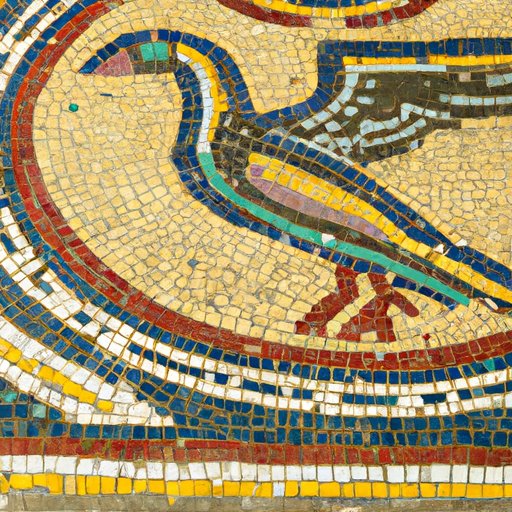Introduction
Looking for a new, exciting hobby or love admiring beautiful art? Look no further than the world of mosaics! This art form has been around for thousands of years and can be found all around the world, from ancient ruins to modern cityscapes. In this article, we’ll explore what a mosaic is, its history, and how it continues to be relevant and beloved today. So let’s dive in!
Discovering the Art of Mosaics: A Beginner’s Guide
If you’ve ever seen a mosaic artwork, you know it’s a sight to behold. But what exactly is a mosaic? At its most basic, it’s a type of art made by assembling small pieces of colored glass, stone, or other materials into a pattern or picture. The art form likely originated in Mesopotamia around 4,000 years ago, and over time, it spread throughout arts and crafts traditions all over the world.
Creating a mosaic requires a variety of tools such as glass cutters, nippers, grinders, and hammers. The materials can range from traditional items like glass, marble, and ceramic tiles to more unique items like shells, CDs, and reclaimed objects. If you’re interested in trying your hand at creating your own mosaic, there are many resources available both online and in-person, from instructional videos and blogs to local workshops and classes.
Unveiling the Meaning Behind Mosaics: From Ancient Art to Modern Décor
One of the most fascinating aspects of mosaic art is the symbolism and meanings that can be embedded within the artwork. Throughout history, mosaics have been used to tell stories, capture important moments, and depict religious or spiritual themes. For example, in ancient Greece and Rome, mosaics were used to depict gods and goddesses in temples and public spaces. In medieval Europe, mosaics were often used to depict religious scenes, with each color and pattern holding its own symbolic meaning.
Today, mosaic art continues to be a popular choice for many homeowners, designers, and artists looking to add a unique and meaningful touch to their spaces. Whether you’re using traditional materials or incorporating more modern ones, mosaics can add a pop of color, texture, and personality to any room. One popular modern twist is to create a mosaic art wall in your home, using a design that incorporates meaningful symbols, such as stars, flowers, or animals, to create a unique and personalized artwork.
Exploring Different Styles of Mosaics from Around the World
Mosaic art has been found all around the world, from ancient Roman ruins to contemporary cityscapes. Some of the most popular mosaic styles include Byzantine, Roman, Islamic, and Venetian. Each style has its own unique characteristics, from the intricacy of Byzantine designs to the boldness of Roman mosaics.
Some styles incorporate different materials like mirrors, shells, or beads, while others rely solely on traditional materials like glass and stone. Additionally, certain cultures have their own specific designs and techniques, often incorporating symbolism and stories from their own traditions. One example is the Huichol Indian mosaics of Mexico, which use traditions and history from the tribe to create intricate, brightly-colored works of art.
Mosaics in Motion: How Mosaic Art is Being Used in Public Spaces
In addition to being a popular choice for homeowners and decorators, mosaic artwork is also used extensively in public spaces. Tiles can be used to create murals, flooring, and even public seating. One of the most famous examples of this is the New York City Subway, where mosaics can be found throughout the stations and on platform walls.
Public mosaic art has also been used to promote messages of community and pride. For example, the AIDS Memorial Quilt is a massive collection of individual panels, each one created as a memorial to a person who died of AIDS-related causes. Each panel is a unique work of art, often incorporating mosaic patterns and designs to tell the story of the person being honored.
From Ancient Pompeii to Contemporary New York: The Enduring Beauty of Mosaic Art
Despite the many changes and innovations in art and technology over the years, mosaic art continues to be a beloved and beautiful art form. From the ancient ruins of Pompeii to modern-day cities like New York and Tokyo, mosaics can be found around every corner.
Traditional mosaic art has been given a twist in recent years, with many contemporary artists experimenting with new materials and techniques to create one-of-a-kind works of art. For example, glass artist Dale Chihuly has experimented with creating larger-than-life glass mosaic sculptures, incorporating light and color to create truly awe-inspiring works.
Conclusion
Mosaic art is a versatile and timeless art form that has a rich history and endless possibilities for creativity. Whether you’re looking to create your own work of art or simply admire the beauty and complexity of existing works, there’s no denying the enduring appeal of mosaics. From the symbolism and story-telling of ancient mosaics to the pop of color and texture found in modern décor, mosaic art is a breathtaking way to tell stories, celebrate cultural traditions, and create memorable works of art.
